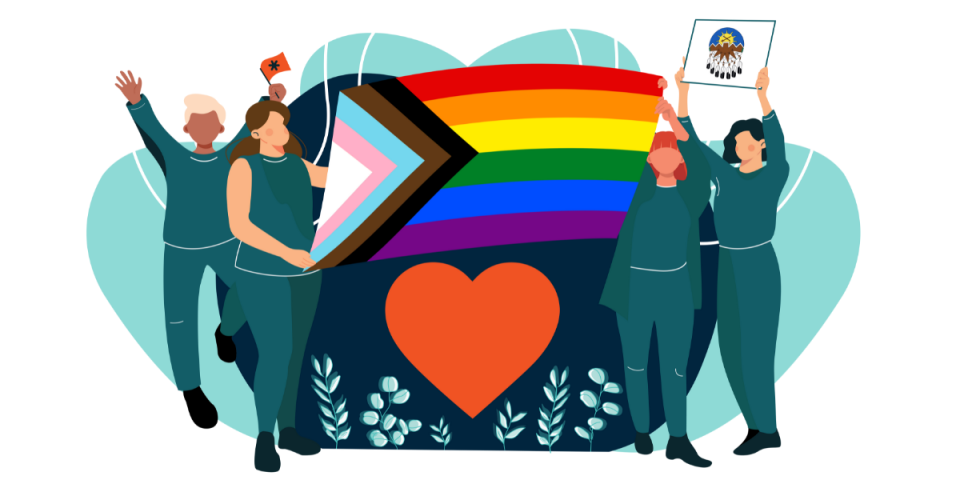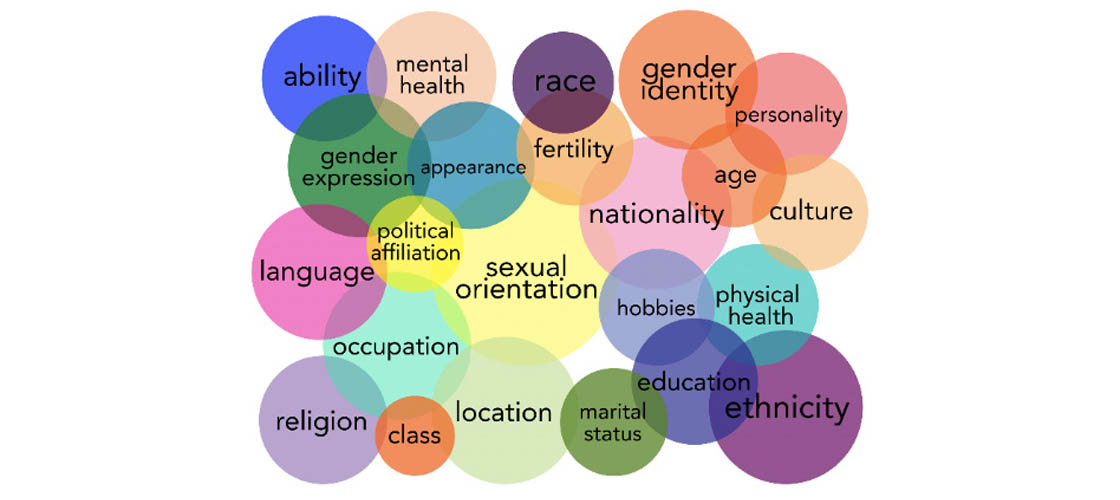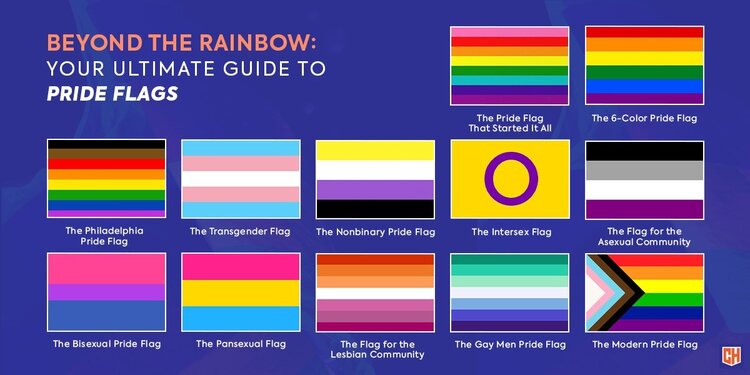
Inclusive Workplaces
Breaking Barriers and Celebrating Women in Tech on International Women’s Day
Blog

Pride started as a protest. It was a movement for those most marginalized in society and a way to use their voices to ask society to do better. It is necessary to acknowledge how essential the work of trans women and 2SLGBTQIA+ people of colour was in the formation of the 2SLGBTQIA+ rights movement.
Today, Pride is marked in countries across the world. Though it is often a celebration, it is also a crucial opportunity to amplify 2SLGBTQIA+ voices, speak out against injustices and push for a more inclusive and equal society that celebrates and recognizes diversity.
And the business sector has a vital role to play in this.
2SLGBTQIA+ workers often struggle with coming out and feeling safe in the workplace. For many people, the decision to come out is contingent on whether they perceive the environment to be inclusive.
With the proliferation of legislative, political and cultural attacks against 2SLGBTQIA+ communities worldwide, many companies have issued public statements of allyship and solidarity.
However, public solidarity statements without internal culture changes and active support for 2SLGBTQIA+ rights is what is called performative allyship.
The time for actionable leadership in workplace allyship to increase diversity, equity, and inclusion measures is now.
An ally is a person who supports and advocates for 2SLGBTQIA+ identities and communities. Allies actively challenge homophobic and transphobic behaviour, language, and systems that disadvantage or hurt 2SLGBTQIA+ folx and communities.
Allies also work on their own learned behaviour and biases. Anyone who actively supports Two Spirit, Transgender, and 2SLGBTQIA+ folx, whether inside or outside 2SLGBTQIA+ communities, can be an ally.
What is intersectionality? Put simply, intersectionality is the concept that all oppression is linked. The Oxford Dictionary defines intersectionality as “relating to different social categories such as race, class and gender and the way that these can combine to result in additional disadvantage or discrimination.”
Expanding on this definition, intersectionality is the acknowledgement that everyone has their own unique experiences of discrimination and oppression, and we must consider everything and anything that can marginalize people, such as:

Here’s an example: If a person is Indigenous and also identifies as transgender, they may face discrimination stemming from racism, transphobia, intergenerational trauma, colonialism and more. There is much more that could be said on this topic, and we encourage you to dive deeper – so you can truly understand how to address intersectionalities to create welcoming and inclusive workplace environments.
Ally tip: It is leaders’ (and everyones’) responsibility to understand intersectionality as it relates to 2SLGBTQIA+ folx, causing them to be underrepresented and discriminated against – especially in the workplace.
Performative allyship is performing a broad gesture that is symbolic in nature but does nothing to improve marginalized employees’ status.
Here are some performative actions to avoid, during Pride and year-around, with ideas for better alternatives and more impactful practices:
Avoid rainbow-washing your product to sell more during Pride Month and Pride Weeks
Rainbow-washing is a process that involves the use of Pride symbolism, such as rainbow colours, in areas such as product design and general branding and marketing – only during Pride month. Brands often capitalize on Pride symbolism to match the heightened spotlight on 2SLGBTQIA+ individuals and communities and sell products in the process.
Instead: Aim to implement more meaningful forms of allyship – such as:
Avoid only using the rainbow Pride flag and forgetting to use the ones representing the groups you’re celebrating!
Pride is often seen as synonymous with the six-colour Pride flag, rainbow-coloured symbols, and emojis. Grouping all identities together and, consequently, their experiences can generalize the individual challenges faced by different gender and sexual minorities.
Instead: Highlight other marginalized communities (and their respective flags) in your Pride celebrations and center inclusion to recognize and support intersectional 2SLGBTQIA+ identities.
Recommended resource: Beyond the Rainbow: Your Ultimate Guide to Pride Flags by Cade Hildreth.

Avoid hosting panels that feature people with uniform identities and experiences
The breadth of experiences encompassed within 2SLGBTQIA+ communities is incredibly diverse! Aim to diversify the stories and perspectives you highlight in your panels, events and spotlights and, especially, uplift underrepresented voices.
Instead: Make Pride celebrations intersectional by supporting and representing marginalized 2SLGBTQIA+ communities. Be specific about which underrepresented or marginalized groups you are highlighting, i.e., avoid acronyms such as BIPOC (try to use full forms – Black, Indigenous and people of colour), or mention groups by name individually. This helps to reduce the generalization of various experiences under a single acronym.
Avoid restricting your recognition of 2SLGBTQIA+ contributions and current issues to a single month
The struggles experienced by marginalized communities exist year-round and deserve to be highlighted beyond just Pride month. Avoid concentrating on initiatives that only center and support 2SLGBTQIA+ experiences and accomplishments taking place during June.
Instead: Consider Pride a great time to lay the groundwork and permanently integrate 2SLGBTQIA+ inclusion within your workplace culture and values.
Some examples of ways to do this include:
Avoid supporting Pride but continuing to work with others that don’t
Supporting Pride and 2SLGBTQIA+ communities but continuing to work or do business with companies, countries and individuals that do not support 2SLGBTQIA+ rights can create a breach of trust and a negative impact.
Organizations that want to create safe workplaces for 2SLGBTQIA+ employees should hold their community to the same standard they employ. Otherwise, they risk putting 2SLGBTQIA+ employees in unsafe situations.
If you’re unsure where to start, look at your policies and see how you can extend them to your 2SLGBTQIA+ employees.
Ally tip: To be an authentic ally, you must foster relationships by connecting, supporting and working with 2SLGBTQIA+ organizations and communities.
It is a sad reality that in 2022, many 2SLGBTQIA+ folx still feel they have to hide who they are at work.
It’s a fundamental human right that 2SLGBTQIA+ employees have the same opportunities as everyone else to unlock their career potential. Instead, many are constantly on guard, watching what they say, what they do, and where they apply for jobs. Leaders and organizations can play a part by creating safe spaces where everyone can thrive.
A recent blog by Lesbians Who Tech & Allies points out that developing an inclusive workplace isn’t just vocally and outwardly supporting the 2SLGBTQIA+ communities — it’s facilitating an atmosphere where all employees and leadership can demonstrate genuine allyship to one another, regardless of identity.
Additionally, the Stonewall organization outlines how you can help make a welcoming and inclusive workplace environment, leading to a healthier, more innovative and open culture for all.
Here are concrete actions you can take as leaders in allyship:
Take accountability; allyship starts with you
As a leader in the workplace, it’s your job to ensure that your policies are inclusive of all employees. Specifically, your policies should prioritize the well-being of employees who exist at intersections of marginalization.
Rally senior leaders to be active champions for Pride networks
Workplaces are most successful at helping everyone thrive when a culture of inclusion is led top-down. Reach out and encourage senior leaders and directors to be vocal champions for inclusion and diversity networks!
Educate yourself and others
Take the time to learn about the experiences of 2SLGBTQIA+ communities by reading articles, watching videos and following advocates on social media. You can then share this information with your employees and help foster a workplace learning culture.
Consider your privilege, and don’t assume
Recognize your privileges and use them to create a safer, more inclusive and equitable workplace. Rarely are individuals in the majority expected to change their manner of speech, appearance, and behaviour to assimilate into the workplace. In contrast, marginalized folx do so that it doesn’t further negatively affect others’ biases and misconceptions.
Don’t expect to be perfect immediately
You may hit roadblocks or unintentionally say things that upset others during this learning process. It’s OK to be kind to yourself during this journey and accept the learning curve. But it’s also essential to be accountable and actively change hurtful behaviours.
Don’t ask 2SLGBTQIA+ folx intrusive questions
It’s never polite to ask probing questions about our colleagues’ lives, but 2SLGBTQIA+ folx often get asked personal questions about topics from their sex lives to their bodies. It’s OK to be curious and to want to learn more, but it’s always better to wait for a colleague to offer the information themselves.
Step back and ensure you’re centring on the voices of 2SLGBTQIA+ folx
Allies need to use their voice to stand in solidarity with more marginalized communities – but it’s equally important to recognize your privilege and know when not to take up space. Listen to 2SLGBTQIA+ folx and provide platforms for them when appropriate and possible.
Provide support and understanding for affected families
2SLBGTQIA+ communities are under attack legally and politically. Employees could now be considering other employment options and relocating because they need to ensure their family is safe. If your company can provide accommodations, let them know you can provide support.
Practice active inclusivity
Don’t have gender-neutral restrooms? Change signage to provide for ample inclusion. Another small, meaningful change is ensuring all employees have their gender pronouns in their email signatures and website biography pages. Most importantly – ask your employees what they feel needs to change to make the workplace more inclusive.
Enact formal DEI guidelines for staff to follow
Nothing is real if it’s not documented! Ensure that your employee codes of conduct, dress codes, standards and practices for reporting, and health insurance policies are gender-inclusive and use accessible language. This is critical to creating a safe environment for your 2SLGBTQIA+ employees that is supported by policy. Make sure your AI and machine learning are inclusive in techie-specific spaces, too!
Institute a zero-tolerance policy
Do not overlook micro-aggressions in the workplace. Catering to just the heteronormative assumption of a singular 2SLGBTQIA+ experience and speculation of sexuality are just a few examples. Address intentional harmful speech swiftly and actively to stop discrimination quickly. Once DEI guidelines are in place, consistently follow them.
If they don’t align, then don’t give a dime
The phrase “put your money where your mouth is” truly applies. To who your organization gives money is a reflection of your values. There are several worthy organizations in your local community and globally to support that will show your support to 2SLGBTQIA+ communities and will also make for a more diverse and productive workplace.
Ally tip: You must be an ally to all 2SLGBTQIA+ folx, including people of colour, trans, non-binary, and disabled people, whose voices are not heard as often.
Folx: we can and need to do better in allyship in workplaces – but beyond this – in our communities, all levels of government and worldwide.
Even the most outwardly progressive organizations need to learn to practice workplace allyship.
Ally tip: With more leaders as allies, your 2SLGBTQIA+ employees will feel more comfortable bringing their whole selves to work. Your DEI programs will be legitimate, not performative. And we all benefit from that.
But wait, there’s more! We leave you with a list of resources to learn more about allyship, 2SLGBTQIA+ folx, their communities, terminology, intersectionalities and best practices in leadership.
This list is by no means exhaustive, but it is a solid foundation for leaders and organizations to research and embed allyship into the workplace and support Pride to be welcoming and inclusive of all folx.